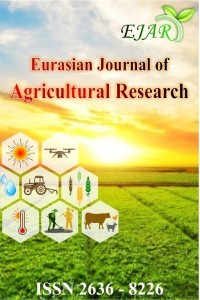Effect of Inoculation of Earthworms and Soil Microorganisms on Soil Structure and Productivity of Alfalfa
Effect of Inoculation of Earthworms and Soil Microorganisms on Soil Structure and Productivity of Alfalfa
Alfalfa, Earthworms, Forage crops Soil microorganisms,
___
- Bratanov, K., 1987. Agricultural encyclopedia, Vol II, Bulgarian Academy of Sciences, p. 704. (in Bulgarian).Butt, K. R., 2011. The Earthworm Inoculation Unit Technique: Development and Use in Soil Improvement Over Two Decades, In: A. Karaca (Ed.), Biology of Earthworms. Springer, Berlin, 87–105.Doran, JW, Sarrantonio M, Liebig MA, 1996. Soil health and sustainability, Advanced Agronomy. 56:2–54.Edwards, C. A., J. R. Lofty, 1980. Effects of earthworm inoculation upon the growth of direct drilled cereals, Journal of Applied Ecology, 17, 533–543.Georgieva, N. and I. Nikolova, 2012. Density and reduction of the stand at alfalfa varieties (Medikago sativa L.), Banat’s Journal of Biotechnology, 3(2), p.18-22.Lavelle P., S. Barot, M. Blouin, Th. Decaëns, J.J. Jimenez, P. Jouquet, 2007. Earthworms as key factors in self-organized soil systems. In: Cuddington K.J.E.B., W.G. Wilson, A. Hastings (Eds.): Ecosystem Engineers: From Plants to Protists, Theoretical Ecology Series, V chapter. The Netherlands. Elsevier, p. 77-106.Lenkov, L., 1973. Horticulture, Zemizdat, p.264. (in Bulgarian).Nikolova, M., E. Andres and K. Glas, 1995. Potassium – nutrient element for yield and quality, International Potash Institute, Basel, Switzerland. p.60. Six, J., Bossuyt, H., Degryze, S., Denef, K., 2004. A history of research on the link between (micro) aggregates, soil biota, and soil organic matter dynamics, Soil Tillage Research, 79, p.7–31. http://dx.doi.org/10.1016/j.still.2004.03.008Turbé A, A. Toni, P. Benito, P. Lavelle, N. Ruiz, W.H. Van Der Putten, E. Labouze, S. Mudgal, 2010. Soil biodiversity: functions, threats and tools for policy makers. Bio Intelligence Service, IRD, and NIOO. Report for EC, p.250.Van Elsas JD, Trevors JT., 1997. Modern Soil Microbiology, New York: Marcel Dekker.
- ISSN: 2636-8226
- Yayın Aralığı: Yılda 2 Sayı
- Başlangıç: 2017
- Yayıncı: Muhammed Cüneyt BAĞDATLI
Gyanden Peter KUGHUR, Ruth, M. ASEMA, Oluwafema A. ADEDEJİ
Yasemin VURARAK, Mehmet Emin BİLGİLİ, Pınar ÇUBUKÇU
GROUPING AND SELECTION OF 32 SINGLE CROSS SUNFLOWER HYBRIDS USING PRINCIPAL COMPONENT ANALYSIS
RURAL FARMERS’ PERCEPTION OF COMMUNAL CONFLICTS IN BENUE STATE, NIGERIA
